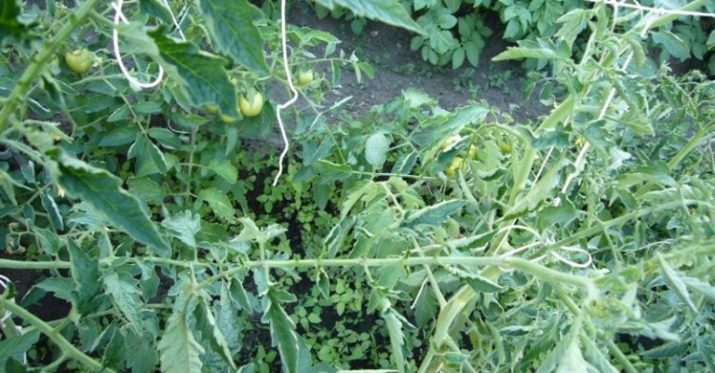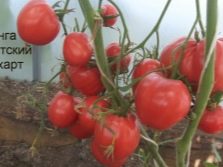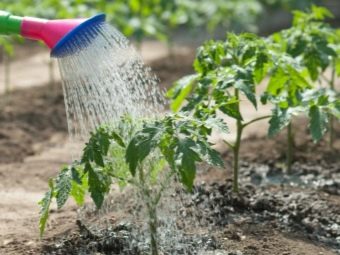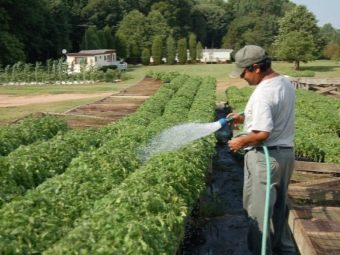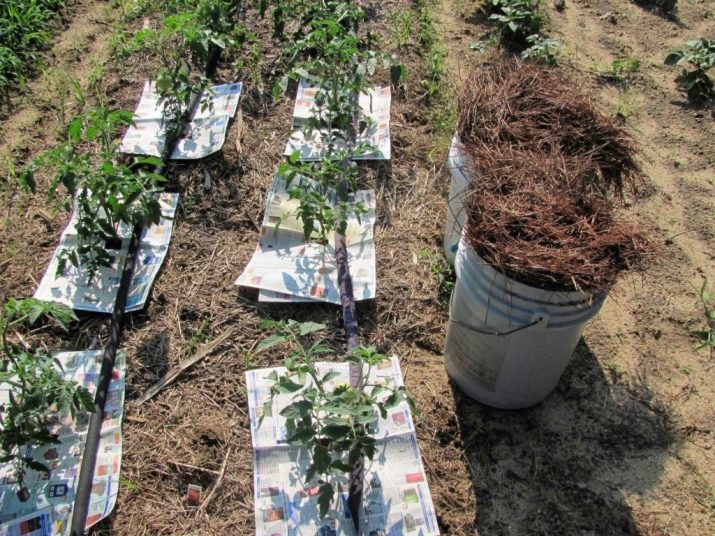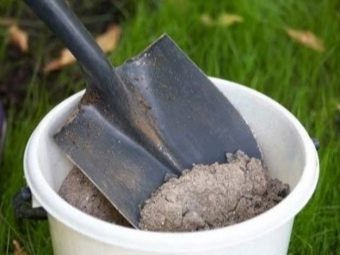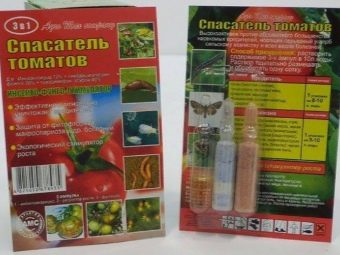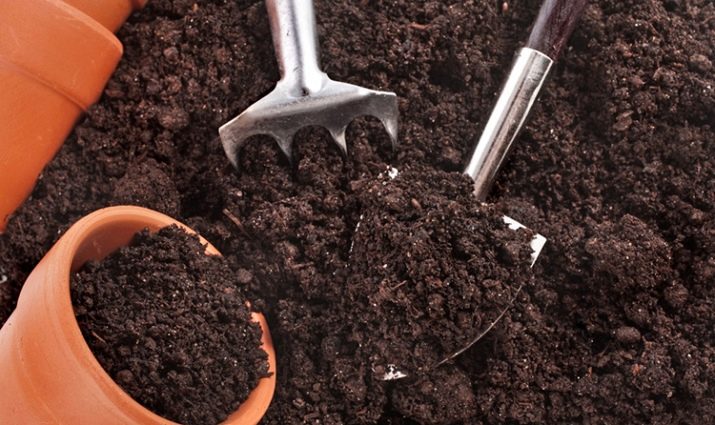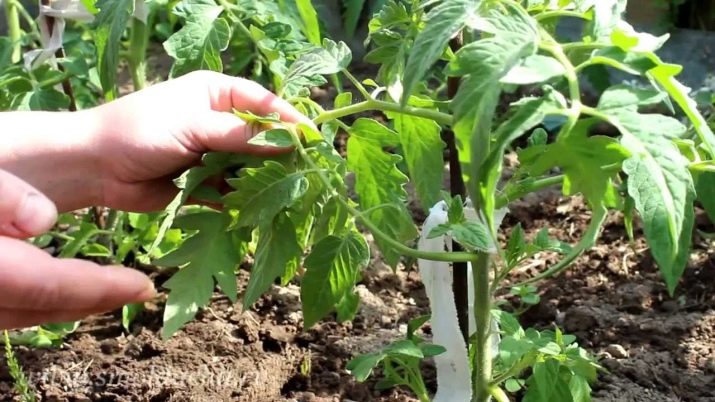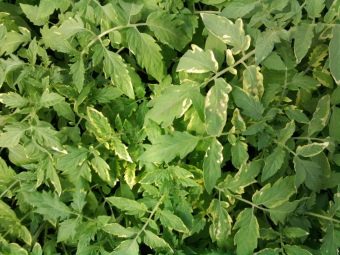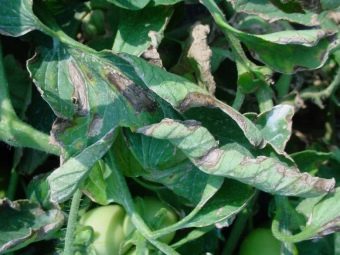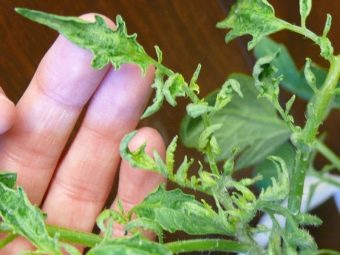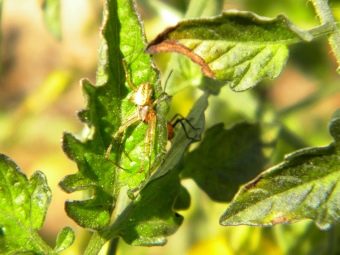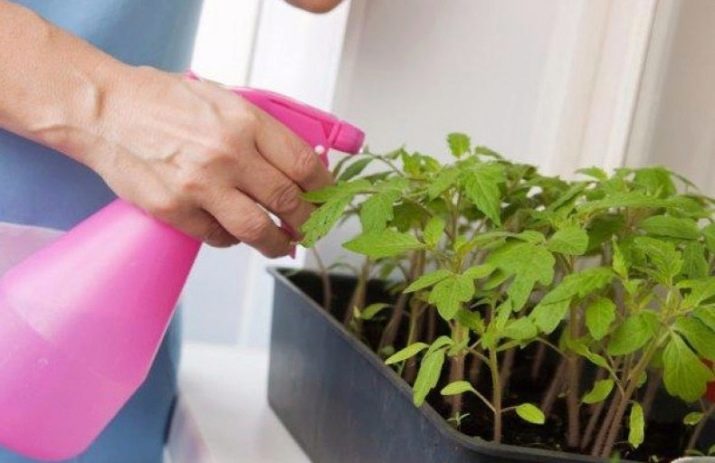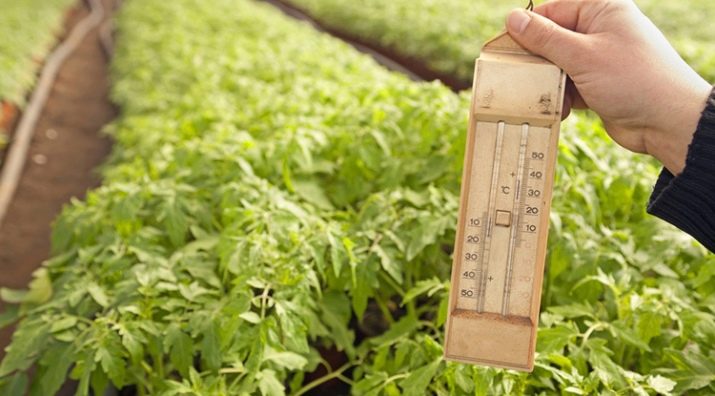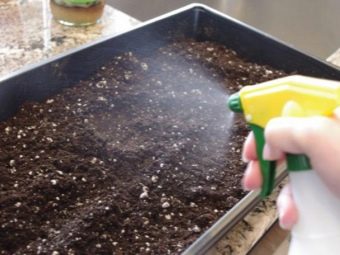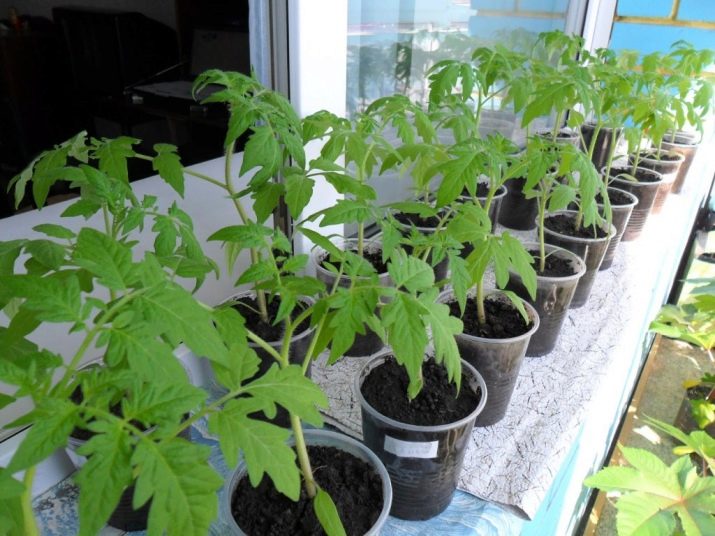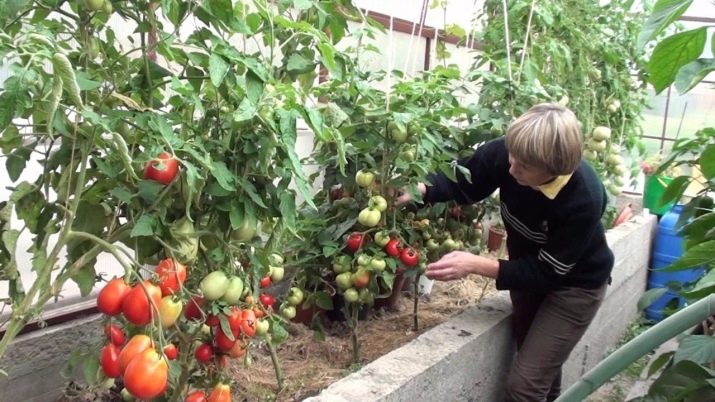Why do tomato seedlings curl leaves?
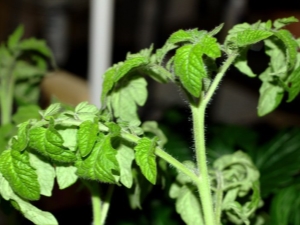
Thermophilicating tomatoes are perceived by many of our compatriots as almost the main symbol of summer, because they are present on the beds of the absolute majority of gardeners. Moreover, such a culture can hardly be called unpretentious - there are more than a dozen reasons that can destroy it. That is why tomatoes need an eye and an eye, and gardeners usually try to identify a potential problem before it starts. It is not surprising that the suddenly curled leaves of a tomato seedling can plunge an inexperienced summer resident into a slight despondency.
The causes of this problem can be many, and the wrong actions due to erroneous diagnostics, of course, will not bring benefits, because it is worth understanding what is happening and what to do in each of the situations.
Special features
There are so many reasons for leaf curling of tomato seedlings that they can be divided into three large groups - improper care, diseases and pests. Naturally, the principle of action in each case is different, and the first impulse of each gardener is to act immediately, until the prospects for the harvest are completely clouded. The most interesting thing is that there is a situation in which the twisting of the leaves does not mean anything at all, and therefore no action should be taken.
The fact is that for many varieties of tomatoes, leaf curling is indeed a sign of the existing problem, but there are also varieties for which this phenomenon is considered the norm of development. These include, for example, "Fatima", "Oxhart" and "Honey drop", quite often this characteristic is also characteristic of cherry tomatoes. As a rule, such a twisting does not look so strong, and the shoots against the background of such a “pathology” suddenly look completely healthy.
Of course, it is better to know about such a feature in advance - then an unusual type of seedlings will not be a reason for panic. More importantly, the understanding that such a species is not a sign of the disease, in many cases, can simply save the seedlings, because it is possible that a frightened and unaware gardener will rush to fix non-existent problems and simply heal the plant.
The reasons
As practice shows, in the overwhelming majority of cases, the reason why leaves are curled around tomato seedlings is simply wrong care. Accordingly, it is only necessary to correct in time for the young plants to return to normal.
Insufficient watering is often the reason that the leaves curl, and often the problem is not even in frequency or abundance, but in the banal irregularity of the process. First you need to deal with the frequency: the seedlings are usually watered every 2 days, tomatoes growing in open ground - once in 2-3 days, and if the soil around is mixed with mulch - even once every 5 days. At the same time the plant, which has already acquired the ovary, you need to water more abundant - up to one bucket per bush.
It is important not to fill it all at once - you need to divide the bucket into several portions, each of which is filled only after the previous one has been absorbed into the ground, because otherwise not the whole volume will reach the roots. By the way, you need to water the tomatoes strictly in the morning or in the evening, but not in the afternoon, otherwise there is a risk of burning the leaves.
Too abundant watering is also a problem to which seedlings react, twisting leaves up. If there is such a phenomenon, watering is generally stopped for a few days. In the case of adult plants, such a break can last even up to one and a half weeks. If excessive watering is caused by natural factors such as excessive rainfall, care should be taken to create drainage channels.
Of course, it is better to choose the site in advance, planting tomatoes in a light, loose soil.
The intense heat contributes to the fact that the leaves wrinkle and curl, especially at the crown, because even a thermophilic tomato does not always withstand the scorching sun. The simplest solution in greenhouse conditions is regular ventilation, which should not lead to the formation of drafts. On the garden, the variety of options is much wider - you can shade plants a little, or you can water them more often.
Other methods of dealing with heat include covering the ground (not the plants themselves!) With agrospanum or hay, and spraying the bushes with foliar top dressing in the form of aqueous solutions of urea and potassium sulfate.
Both lack and excess fertilizer can cause tomato leaves to wrap. The problem of shortage is solved simply - you should use complex fertilizers, simply following the instructions on the package. With an overdose, things are somewhat more complicated, because when the soil is saturated with a certain mineral, you can simply kill the plant. If there is a lot of zinc in the soil, leaf twisting is accompanied by the acquisition of purple color by the lower part of the bush. An excess of manganese leads to pronounced wrinkles on the twisted leaves, which later become unnatural, too green.
With an overdose of nitrogen, there is a curtailment of the upper leaves, and it is this symptom that is most dangerous because this substance is capable of burning the roots. The last situation cannot be rectified by simply stopping feeding. The seedlings need to be rescued urgently. To do this, under each plant, 70 g of ordinary wood ash are added to the moistened soil; as an alternative, 10 g of potassium sulfate can be used per square meter of bed.
The lack of trace elements, which are building elements for the body, is harmful for tomatoes as well as for humans. If a tomato lacks phosphorus, it will react with twisted and gray leaves, and you cannot do without the use of superphosphates. Yellowed, and in severe cases, blackened leaves, which can dry out and fall off, indicate an insufficient amount of copper.
Curling up of the leaves may indicate a lack of calcium, and if there are additional signs imperceptible on the seedlings, then in an adult plant this problem is also expressed in the rotting of the berries. The lack of potassium causes the leaves to curl toward the center, starting at the edges. If signs of twisting are not observed at the top or bottom, but in the middle, and even on the yellowed leaves, red veins appear, then the plant needs more boron. If the sheet as a whole sags down, but its end still stretches up, the problem is the lack of iron.
All these problems can be solved with the help of complex fertilizer, as well as with preparations of a specific microcell.
Mechanical damage to the roots, of course, can also cause leaf curling. This often happens when a plant is transplanted from a pot of seedlings to open ground or when picking. If a similar phenomenon occurred abruptly and almost immediately after such operations, then the reason probably lies in them. It is impossible to help a plant here, but in most cases it is able to bring itself back to normal, but this can take a week.
"Heavy" soil can also be the cause of foliage folding, because it does not allow water to pass through and contributes to the rotting of the roots. This problem is very related to abundant watering, only the mechanism of violation here looks a little different. It is possible to make watering less frequent and plentiful, but in general, this error is pathological - once the tomatoes were planted in another place, where the ground is light and loose.
Excessive air humidity is also related to abundant watering, only if at the last leaves coagulate due to rotting of the roots, then with highly humidified air, the effect of moisture is directed directly at the foliage. Tomatoes normally tolerate moisture up to 60%, and an indicator above 70% is destructive for them. Outdoors in our country, such indicators are impossible - this happens only in greenhouses, because a greenhouse will be a good solution.
Keep in mind that drafts for seedlings are very unpleasant.
Even the wrong pinching can make the leaves take an atypical shape. Removing any part of the plant leads to the fact that it is under stress, because it is absolutely unacceptable to immediately remove all stepchildren at a time - this not only does not benefit, but also causes harm. Again, you should not remove the "extra" shoots immediately - it is worth giving them time to stretch at least 6 cm in length.
Diseases
The reason that the leaves of tomatoes wither and twist inside, often appear various diseases. Their list can be quite impressive, but most often there are three diseases that are a completely typical problem for tomatoes:
- Bacteriosis is one of the most pernicious problems for seedlings. Spinning leaves with such a diagnosis becomes so obvious that they literally coagulate into a tube, and new ones grow very slowly and become much smaller. If the bush has managed to bloom, its flowers are characterized by a characteristic white color. Unfortunately, the infected plant disappears, which is why it makes sense to destroy it on its own before it has managed to infect neighboring bushes. The transfer is carried out with insects, because the neighboring seedlings are treated with insecticides.
Although bacteriosis is not treated, there is effective prevention against it - for this, the seeds need to be decontaminated before planting.
- Fusarium - a typical fungal infection that is not transmitted from plant to plant, but it is preserved and spreads in the soil, therefore, the lower leaves are bent in the first place. It is impossible to save the diseased plant, but it is necessary to disinfect the soil with a concentrated solution of potassium permanganate, otherwise in the future all the bushes on this garden bed will be sick. Neighboring plants, which have not yet noted signs of disease, should be treated with a fungicide - this can save them from infection.
- Thin-leaf virus most clearly manifests itself in a dry summer with an abundance of sunny days. The leaves of the affected plants, especially the upper ones, curl up to the formation of a tubule, and the fruits, if the development of the plant has reached this stage, are distinguished by a marked small size. You can try to cure such a disease by spraying infected plants with a solution of urea and potassium permanganate, but if this does not help, the tomatoes will have to be destroyed.
Pests
Like many other plants, tomato seedlings have pests that include slugs and spider mites, whiteflies and aphids. All these insects consider sap extracted from the leaves of a tomato as a possible food, so it is not surprising that the damaged leaves fold and dry. Twisting is often accompanied by a change in color in the direction of yellowing or the acquisition of a brownish tint.
It is not difficult to establish an accurate diagnosis - it is enough to watch the plant for this, because small insects do not consider it necessary to hide from people.
As a treatment, you can use various chemicals purchased in the store. Their advantage is that they are very effective and able to provide quick results, but it is important not to overdo it with the dosage, because the abundance of toxic substances can adversely affect the seedlings themselves.
In this case, a means against pests can even be prepared independently from the improvised ingredients. Most likely, the effectiveness of such homemade poison will be lower, but then the plants will be less susceptible to its effects.
In order to perplex insects, it is necessary to use onions of onion peel and garlic, decoctions of celandine or yarrow, as well as a solution of ordinary wood ash.
What to do?
The best way to respond to a specific reason for twisting the leaves of the tomato is the only way to gain confidence in the proper end result. However, it is not always possible to accurately determine the cause - sometimes the gardener lacks experience for accurate diagnosis, and sometimes the problem is complex, due to which there are signs characteristic of several problems at once and therefore confusing the summer resident. If this is the case, attempts to save the plants should be arranged in the following order:
- improper watering (both excessively abundant and insufficient) is the most common cause of problems with tomato seedlings, so you need to make sure once again that it is done correctly;
- it is necessary to find a way to measure the temperature and humidity in the room where the seedlings grow, and if deviations from the norm are observed, eliminate them;
- if the recommendations for the cultivation of tomato seedlings allow for feeding in at this stage, and it was not introduced before, then it’s time to try to feed the plants;
- if there are signs of a possible excess of certain trace elements, substances capable of leveling the chemical balance of the soil are introduced into the soil;
- if all the above actions do not help, the probability of infection of the bush with diseases or pests is checked;
- if the infection is actually observed or other causes of leaf curling are excluded, it is necessary to treat the beds.
Prevention and care
It is better not to wait until the problem is fully manifested and cause irreparable damage, and to take care of its prevention in advance. Conscious gardeners begin to prevent various problems and diseases of the plant even before the seeds are planted, and then continue to take preventive measures in the course of seedling growth, thereby avoiding any trouble at all. The algorithm of action of the far-sighted summer resident is as follows.
- Even before planting, future seedlings can be protected from incurable fusarium and bacteriosis. To do this, you need to treat both the soil and the seeds themselves with special formulations.
- It should be responsible approach to the choice of soil in which tomatoes will be planted. For these plants, stagnant water is a real danger, because you need to choose a light loose soil type, which easily allows excess moisture to pass through. Such a ground should be in pots with seedlings, the same should be ensured on a permanent garden bed, because you should think in advance about where exactly the grown tomatoes will be planted in the garden.
- During the cultivation of seedlings is very important to ensure regular ventilation of the room without the occurrence of drafts. As a rule, to achieve this is not easy, so you need to at least remove the seedlings away from the windows. It is also necessary to maintain the correct mode of irrigation so that there is neither too much nor too little moisture.
- Any recommendations regarding fertilizer application to the soil should be strictly adhered to - these are necessarily indicated on the package. Do not think that a slightly more intensive top dressing will provide a more impressive harvest as a result - on the contrary, in the end, you can be left without a crop at all.
- Any problem is easier to solve if it was noticed on time and has not yet had enough time to acquire frightening scales.To this end, tomato seedlings should be regularly inspected for the same twisting or mass wilting of the leaves, you should also pay attention to the possible presence of insects or other manifestations of negative phenomena.
Useful tips
Virtually all aspects that somehow affect the health of tomato seedlings have already been described above, but finally you can give some more important tips that will help to achieve high yields and decent quality of the harvested fruits.
For a start, do not neglect prevention, even if for some reason you are sure that no pests or fungus will ever get to your greenhouse. In fact, the spores of a fungus or insect eggs can even be found in the soil that you scored for growing seedlings, because of a negligent attitude can be permanent problems, the need to repeatedly treat the affected plants and even complete loss of the crop.
Despite the fact that tomatoes have been successfully grown by humanity for hundreds of years, this procedure is by no means simple - especially in our climatic conditions. To ensure a positive result, it is necessary to take into account the mass of small nuances, none of which is insignificant. For this reason, the instruction must be strictly observed in all cases where it is - in particular, this concerns the application of fertilizer and fertilizer.
If a person has no experience of growing tomatoes independently or is relatively small for the time being, it will be useful to read the relevant literature beforehand - if, of course, you want to get a good harvest. Again, the information received does not fall into the category of how to do it - it clearly describes how to do it.
If the problem is still found, it is important not to go to extremes. Of course, only some diseases are fatal for a plant, and even that is not all, moreover, if there are signs of illness in several plants, it is quite possible to try to save those that do not yet show negative dynamics. Consequently, you should not panic or give up, but you shouldn’t allow the situation to take its course, referring to the fact that the situation is not critical.
Even small shifts in the direction of deterioration of the bushes should make the gardener alert, because it may happen that this is only the beginning of major problems that need to be reacted as soon as possible.
It is also important to understand that the wrong solution of the problem can lead not only to its aggravation, but also to the emergence of a completely new one, which was not there before. For example, if, with improper watering or temperature conditions, the cottager decides that the problem lies in the lack of additional fertilizing, he can provoke an excess of certain trace elements in the soil, which also will not benefit the plant. For this reason, it is not worthwhile to rush into making a diagnosis - you should start with a comprehensive study of the problem and check the correctness of irrigation and temperature.
The use of dressings or even more various toxic substances is allowed only when there are clear signs of a problem being solved in this way, or if all alternative measures to save the seedlings have already been tried and have not yielded noticeable results.
It is also important to understand that the wrong solution of the problem can lead not only to its aggravation, but also to the emergence of a completely new one, which was not there before. For example, if, with improper watering or temperature conditions, the cottager decides that the problem lies in the lack of additional fertilizing, he can provoke an excess of certain trace elements in the soil, which also will not benefit the plant. For this reason, it is not worthwhile to rush into making a diagnosis - you should start with a comprehensive study of the problem and check the correctness of watering and temperature control.
The use of dressings or even more various toxic substances is allowed only when there are clear signs of a problem being solved in this way, or if all alternative measures to save the seedlings have already been tried and have not yielded noticeable results.
About why the tomato seedlings curl leaves, see the next video.

